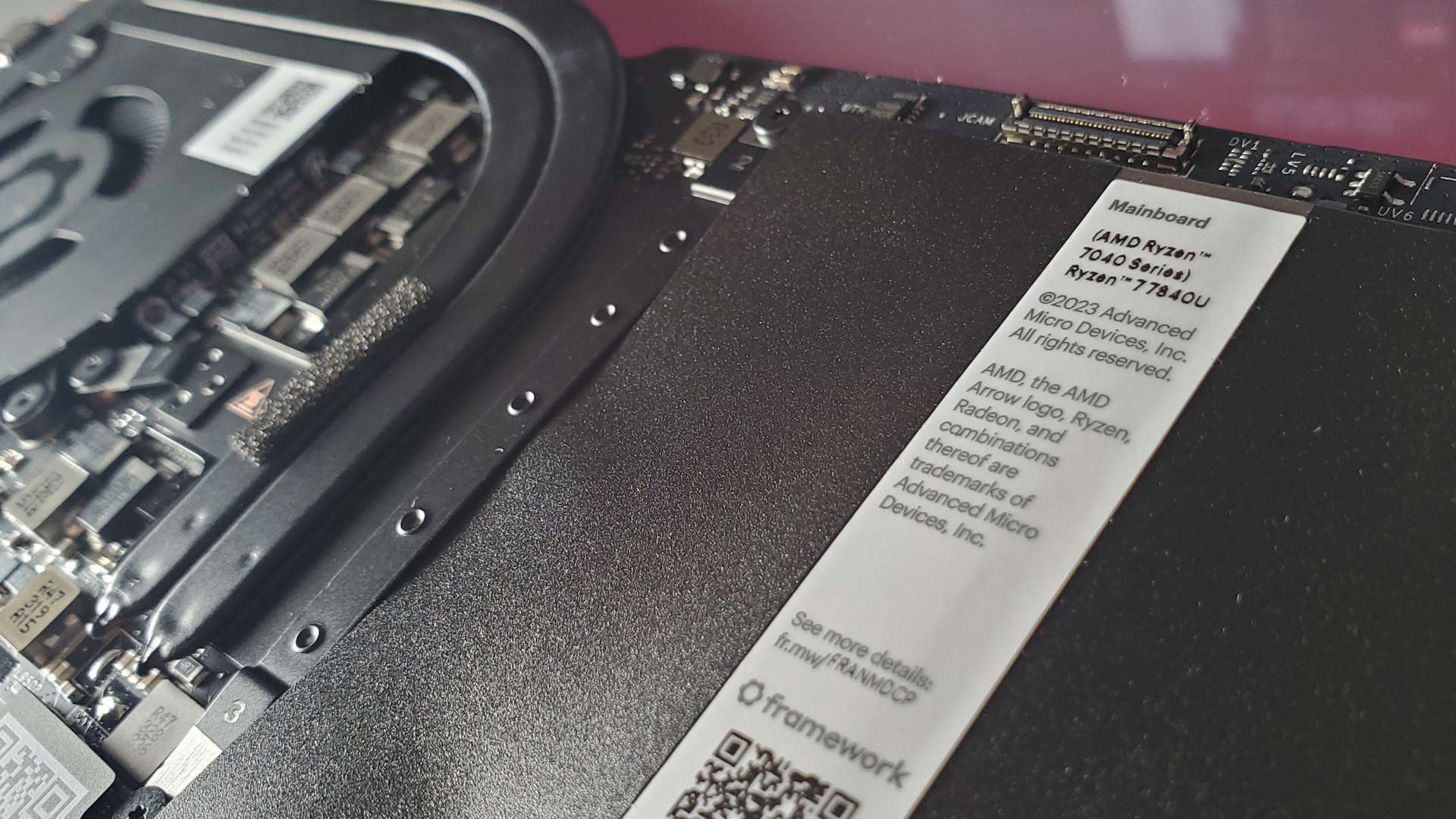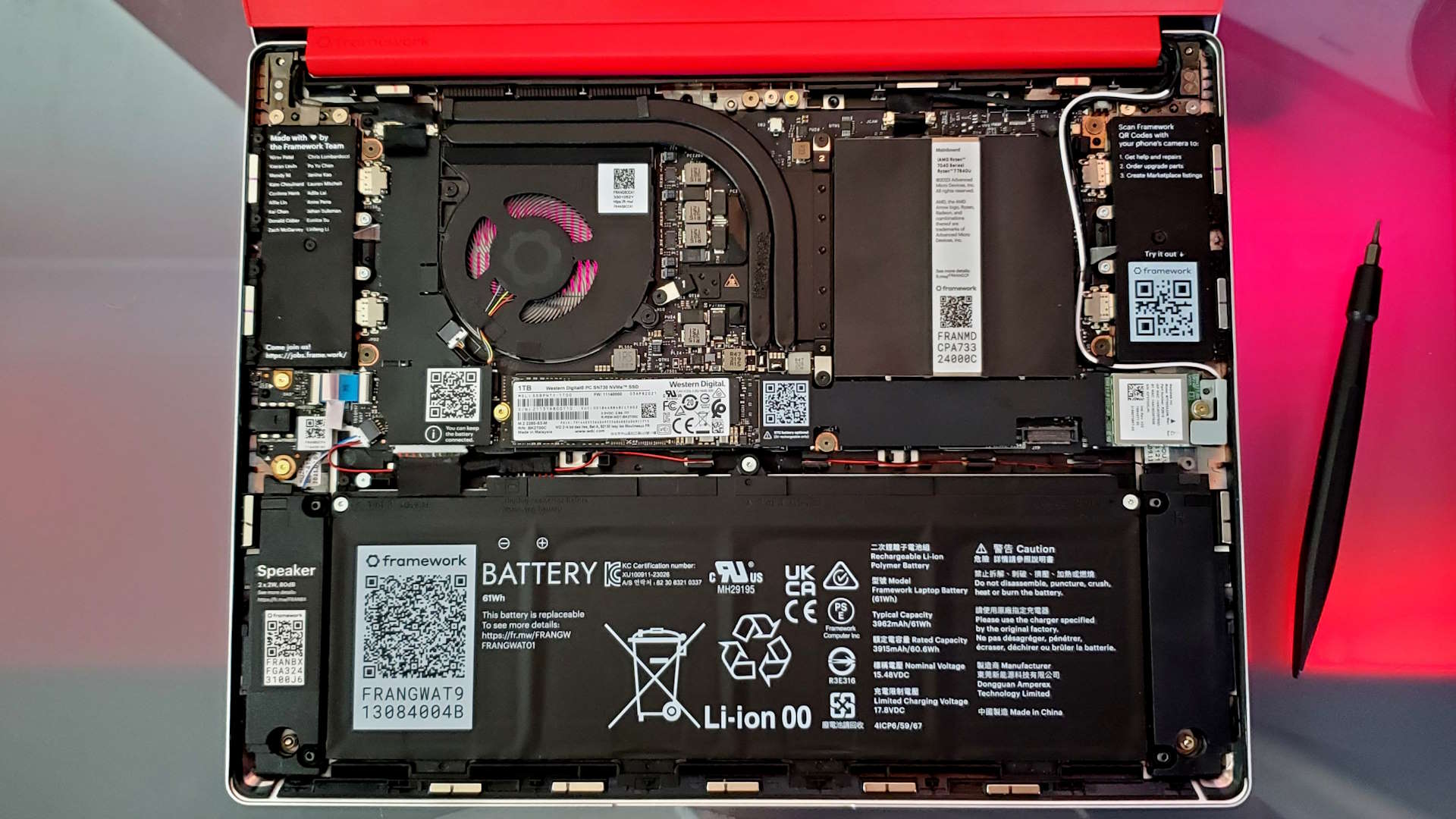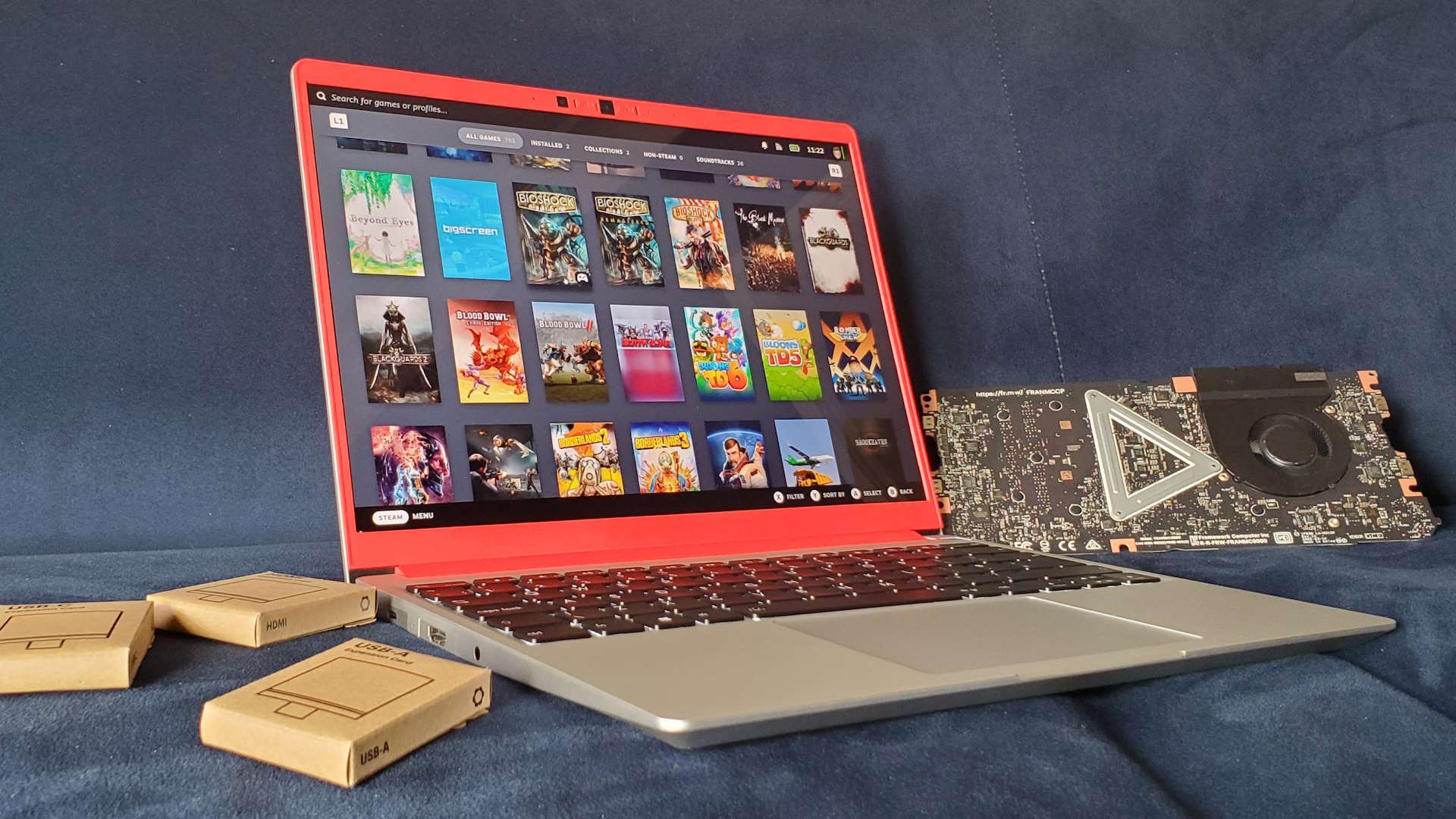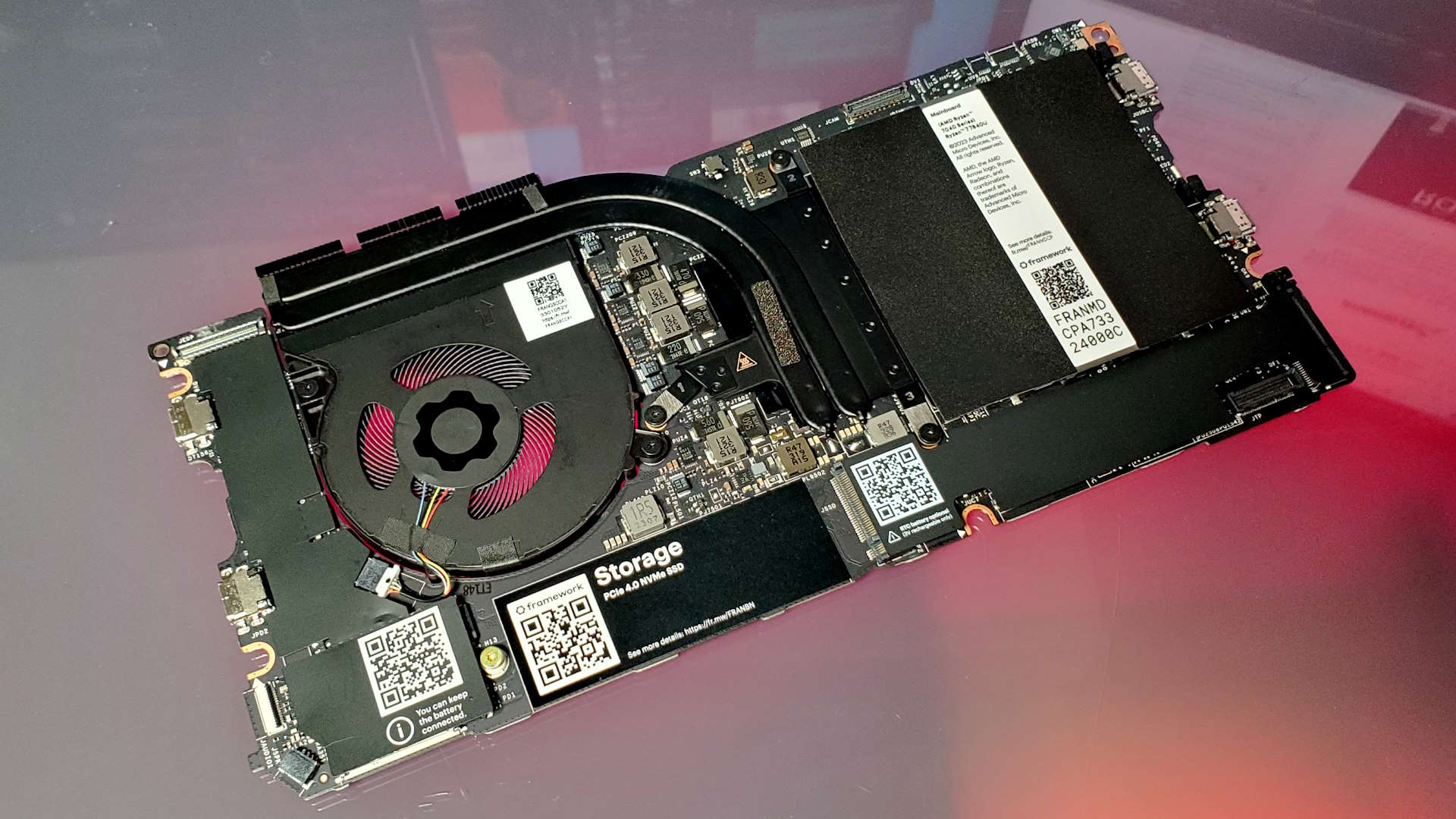Our Verdict
The new AMD mainboard gives it the gaming prowess of a modern handheld PC and greater power and efficiency than the far more expensive Intel Framework boards, too. This is the pinnacle of Framework's 13-inch design, possibly the ultimate hybrid gaming ultrabook, and a laptop I now have a genuine affection for.
For
- Genuine 1080p performance
- Stellar productivity chops
- Cheaper than Intel's best
- And outperforms it, too
- Better battery life
Against
- Trackpad's a touch finicky
- Now I want a higher refresh screen
- Loud when gaming
PC Gamer's got your back
The new Framework AMD mainboard is finally here and now I love the Framework 13 laptop. I mean, I've been very positive about the company's modular notebook setup in the past—and love the idea of a laptop that can be upgraded a few generations down the line—but while it's a good office laptop it never really sung to me as a device itself. Dropping the new AMD Ryzen 7 7840U board into this old chassis, however, has made me fall in love with this laptop in a way none of the Intel upgrades ever did.
In the parlance of our times, the Framework 13 is now a bit of me. I've taken it apart and tinkered with the insides on a regular basis, I've swapped out the screen a couple of times, flipping between matte and glossy panels, and I've got a laptop I know inside and out, that now has some actual gaming chops, too.
My first experience with more or less this exact laptop (this ship of Theseus device) was as a Tiger Lake-based system with an 11th Gen Intel chip inside it. And it was fine. The 13-inch scale is great for a predominantly office-focused notebook, the design is slim and simple, the modular ports are great, and I love the 16:10 aspect ratio of the sharp, glossy 2256 x 1504 resolution screen.
But it's never been a laptop for a PC gamer. Even after replacing that mainboard with a newer 12th Gen Alder Lake, and more recently a 13th Gen Raptor Lake board, those updates only made it a better office machine. Now, I'm not saying that, with the new AMD Zen 4 mainboard upgrade, this is suddenly a rare 13-inch gaming laptop, but it's certainly a laptop that's now got game.
AMD makes all the best mobile chips right now, something only compounded in the gaming scene by the immaculate Ryzen 9 7945HX3D in the Asus ROG Strix Scar 17, and this 7840U chip highlights the red team's effective dominance at the other end of the scale, too. But its dominance is only 'effective' because AMD chips are still somewhat hard to find in a broad range of mobile systems.
The best mobile gaming CPU ever made, that awesome X3D chip, is only available in the one Asus 17-inch machine, and there are still few manufacturers who have a full range of laptops with Ryzen processors inside them. Still, some of the best are AMD-based, such as the gorgeous Razer Blade 14 and the Asus ROG Zephyrus G14. Lenovo's Legion range is starting to boast a decent selection, too.
And now Framework can boast some of the best AMD processors in its lineup as well.
The Ryzen 7 7840U is one of the AMD chips I'm most familiar with because it's the beating heart of all the best handheld gaming PCs of this generation. Yes, the Steam Deck is the gateway drug for handhelds, but it's the current crop that have really made genuine mobile PC gaming a possibility, and that's because of the RDNA 3 compute units at the heart of this stellar APU, and the fact there are 12 of them.
That GPU power translates here to the Framework 13, giving it genuine 1080p gaming performance at Medium, and sometimes even High graphics presets. Even more so if you're playing games with AMD's FSR upscaling tech at play, or even Intel's agnostic XeSS. And that includes a lot of modern PC games right now.


What isn't included in many games today is AMD's new Frame Generation technology that sits alongside its FSR 3 rollout. Which is a shame. I've tested it in Forspoken and you're looking at a huge boost in gaming frame rates from enabling both FSR 3 and AMD's Frame Gen feature. It's a game changer for the handheld market, and the same goes for this wee laptop here, too. Honestly, bring it on, because I hope developers really get on board with AMD's lighter touch, broader approach to frame interpolation.
Sure, it's not quite as effective as Nvidia's hardware-based Frame Generation tech, and if your frame rate is too low it can get a bit laggy and floaty. But when it's a choice of having something that's not quite as good but still pretty damned good, or just nothing at all, well, it's not really a choice, is it?
Upscaling and magic frames aside, the hardware is still effective at native settings if you're a little parsimonious about your image presets.
I have noticed, however, it's not quite as quick in gaming terms as the handheld's I've tested with the same APU inside them. Often only by a few frames per second behind the ROG Ally or OneXFly, but those dedicated gaming devices do have an edge. It might just be down to the different, slightly faster memory inside them at this point, but the difference is there.
And that's just the integrated GPU performance; this is still an eight-core Zen 4 CPU at its heart, with a full 16 threads of processing power and a heady measured 4.9GHz clock speed in this svelte chassis. That means it's a pretty monstrous processor that would have been high-end desktop level just a few short years back.
Compare it with the Core i7 1370P—the pinnacle of Intel mainboard offerings for the Framework 13 laptop—and you're talking about a 14-core chip, with 20 processing threads getting beat by this resolutely eight-core Zen 4 chip. The single thread Cinebench R23 performance of the Intel Raptor Lake CPU does post a significantly higher index score than the Ryzen processor, but that's where it ends.
In pretty much every metric that counts this AMD mainboard excels, and pushes the Framework 13 ahead of its previous Intel innards.
In multi-threaded tasks, where you'd expect the higher Intel thread count to score a win, it's the AMD chip which pulls ahead, whether that's in Cinebench or Blender rendering, or HD video encoding.
In pretty much every metric that counts this AMD mainboard excels, and pushes the Framework 13 ahead of its previous Intel innards. Except one, and it's a bit of an oddity: The SSD performance, with the exact same drive, is markedly lower. Not so low as to be noticeable in actual use—just 1.5 seconds slower in Final Fantasy XIV load times and slightly higher 3DMark Storage latency—but it's still something to note from the benchmark numbers.
You might think that all this extra gaming performance and processing power would demand more juice from the battery at the heart of the Framework 13, but the opposite is true. More power and greater efficiency; I can't sing the praises of AMD's mobile chips more highly. I'm running the upgraded 61Wh battery over the original 55Wh option. On the Intel board that gave it the tiniest boost in battery life from 60 to 68 minutes, using PCMark's Gaming battery life test. The AMD mainboard, however, hits 86 minutes.
By the way, it's also cheaper.
The Core i7 1370P mainboard retails for $1,049 on its own, a hefty upgrade that's the price of an entire gaming laptop of decent spec. This AMD Ryzen 7 7840U mainboard is $699. You are going to need some a couple of DDR5 SO-DIMMs to go alongside your AMD board, and a new WiFi module if you're upgrading from an older Intel Framework board, but that still doesn't get anywhere near the cost of the weaker Intel one.
And this here is the beauty of the Framework model. You could have bought that 11th Gen Framework 13 machine years back, and by dropping in this AMD board and some new memory and you've suddenly got a huge upgrade in performance and efficiency. It's not a cheap upgrade by any means, but it's way less than the cost of an equivalent new laptop and with considerably less ewaste.
It's not a perfect little laptop, however. The trackpad sometimes is a little finicky when it comes to finding the right-click sweet spot, and I'd kill for a glossy version of this 16:10 screen with a refresh rate higher than 60Hz. And it will get loud at the full 30W TDP mode of the Ryzen chip when gaming, too. That tiny fan atop the APU certainly isn't quiet at full chat. Thankfully that is only when you're pushing it to its max, because otherwise the system is whisper quiet.


✅ You want an office laptop that can game: The 7840U's integrated graphics give it the same level of gaming power as a modern gaming handheld, and proper productivity chops at the same time. All in a package that looks like a standard office ultrabook.
✅ You want customisation: The Framework ethos means you can switch ports on the fly. Don't need a USB-A or HDMI connection? Swap it out for another Type-C socket or a DisplayPort instead.
❌ You're after a proper modular gaming laptop: While the 12 RDNA 3 CUs of the AMD APU give it genuine gaming chops, it's not on the same level as a dedicated GPU of a gaming laptop. Maybe a gaming laptop like the modular Framework 16 we're waiting on…
But there are other reasons to be into the Framework scene, though. Its refurb and last-gen sales model means you can get cheaper boards down the line when new ones come out. And if you're likely to be skipping hardware generations because few people will upgrade every time Intel or AMD sneeze in the general direction of a fab, then that makes it potentially more affordable to update when you really need to, or when you can spare the cash to.
That level of upgrade cycle makes it like the desktop PC market in a way, and in a way that has made me feel far more affection for the Framework 13 than any other laptop I've used. This chassis, keyboard, SSD, and screen have been through generations of Intel and AMD silicon with me, and I love this little system.
Maybe it's the sweet new red trim I've now got around the screen, or maybe it's the potent gaming and processing power of the new AMD mainboard, or maybe it's the fact I've had my digits digging around in its guts so many times now we're intimately acquainted.
Whatever it is, this machine is the one I want to be my constant companion. It's the laptop I want to come into the office with me, that I'll sit on the couch with, that I want to take away on trips—business and pleasure—and it's going to deliver on every level.
The new AMD mainboard gives it the gaming prowess of a modern handheld PC and greater power and efficiency than the far more expensive Intel Framework boards, too. This is the pinnacle of Framework's 13-inch design, possibly the ultimate hybrid gaming ultrabook, and a laptop I now have a genuine affection for.

Dave has been gaming since the days of Zaxxon and Lady Bug on the Colecovision, and code books for the Commodore Vic 20 (Death Race 2000!). He built his first gaming PC at the tender age of 16, and finally finished bug-fixing the Cyrix-based system around a year later. When he dropped it out of the window. He first started writing for Official PlayStation Magazine and Xbox World many decades ago, then moved onto PC Format full-time, then PC Gamer, TechRadar, and T3 among others. Now he's back, writing about the nightmarish graphics card market, CPUs with more cores than sense, gaming laptops hotter than the sun, and SSDs more capacious than a Cybertruck.



